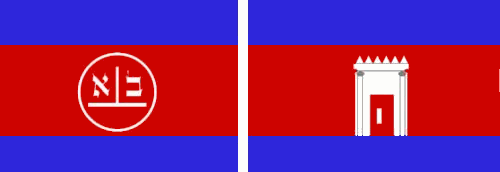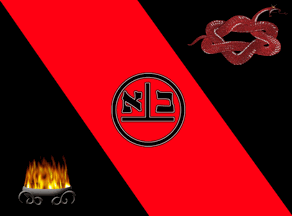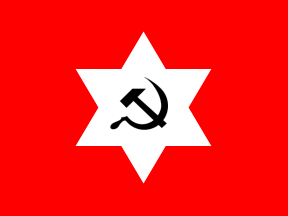
movement flag
image by Alex Rybalka, 29 January 2005

FOTW beschäftigt sich mit der Wissenschaft der Vexillologie (Flaggenkunde).
Alle auf dieser Website dargebotenen Abbildungen dienen ausschließlich der Informationsvermittlung im Sinne der Flaggenkunde.
Wir distanziert uns ausdrücklich von allen hierauf dargestellten Symbolen verfassungsfeindlicher Organisationen.
Last modified: 2023-06-24 by martin karner
Keywords: israel | politics | temple mount faithful movement | tnu'at ne'emanei har-habait | gush shalom |
Links: FOTW homepage |
search |
disclaimer and copyright |
write us |
mirrors
See also:
The 'Provisional Government' of Israel which was the governing
body until the first elections included members who came mostly
from socialist parties. The leading party was Israel Land
Workers Party (MAPAI) which after some unifications and
distributions is today's Israel Labour
Party which was in power in 1948–1977 and 1992–1996. The
Freedom Movement (Kherut) which also after some
unifications is today's Likud Party
was a rival fraction in 1948 and therefore had no part in the
'Provisional Government'.
Dov Gutterman, 19 February 1999
The flags used during the 1999 political campaign lacked any
vexillological value, in my humble opinion. All parties used
flags which were usually the name of the party or a slogan on a
bed sheet. There were so many variants to each party, you cannot
even speak about semi-official flags. Major parties used
combinations of blue-azure-white. Some parties used green on
white or red and white.
The only party that showed something that can be considered as a
semi-official flag was Meretz. In the
flag of Ale-Yarok
(Green Leaf) party, the famous green leaf replaced the Magen
David on the Israeli flag.
Dov Gutterman, 19 May 1999
Both the Likud party, the
Labour party and the Moledet flags all show their
logo [instead of the Magen David] on the national flag which is a common practice in
Israel since many municipalities follow
this pattern too.
Dov Gutterman, 13 December 2000
The Arab Parties in the Knesset are:
Dov Gutterman, 29 December 2000
Voting in Israel is done by choosing a note with letter or
combination of letters printed on it which represent the party
you
desire. Those letters usually don't reflect the real name of the
party.
For instance, the labour party use the combination alef-mem-taf
(which by no coincidence means Emet = Truth) which is
combination of the previous letters of three parties, one of each
no longer part of the labour party – Alef of MAPAI – Taf
from the taf-vav of Akhdut Ha'Avoda and mem of
MAPAM, letter to give the mem to MERETZ). The Likud
party use mem-het-lamed which is also combination of
previous letters of three parties – mem from the ayin-mem
of La'Am, het of
Herut and lamed of the Liberals).
When "Shas" was established the asked and got the
letters shin-sameh, and as become with other parties
(such as MERETZ), the party is more known by its letters then by
its official name.
Dov Gutterman, 12 January 2003
Each party got its own "letter" or combination of
letters which sometimes became a second "nickname" for
the party or sometimes its publicly known name. Those letters
are not alaways connected with the party name.
Therefore the Labour Party is sometimes regarded also as Reshimat
Emet (Emet List). Same goes with the leading Likud Party,
sometimes also regarded as MAHAL list becouse of its letters:
Mem-Het-Lamed.
From the other hand, Shinui Party in not known as YESH (Yud-Shin)
list but as "Shinui" and same goes about the MAFDAL
which is not BET list.
The extreme case is SHAS which is publicly known only by its
letters (Shin-Sameh) and almost never regarded by its official
name.
Dov Gutterman, 10 June 2003
After series of wrong doings by parties, especially in with
raising and using of funds, the Knesset enacted an act in 1992
that specify rules about what is right and what is wrong.
Since 1992, when registration become obligatory, 74 parties were
registered. 2 already notify their disseverment so, today 72
parties are registered.
However, many of those parties exist only on paper or stopped any
activity, and just didn't bother to dissolve officially. Only 37
parties in 31 lists take part in 2006 elections.
Dov Gutterman, 28 March 2006

movement flag
image by Alex Rybalka, 29 January 2005

personal standard of the leader
image by Alex Rybalka, 29 January 2005
I have information about the flag of Israeli right-wing
movement "Bead Artseinu". The flag have two sides –
Temple and sign of "Jewish plus", which symbolizes
doctrine of Hyperzionism.
The second image is the personal standard (banner) of the leader
of the Movement.
Information received from leader of Movement, Rabbi Abraham
Shmulevich.
Alex Rybalka, 29 January 2005
Seems to be aimed at Russian-speakers, interestingly. Don't
read anything too nefarious into the "Jewish plus".
It's used by some Jews uncomfortable (for religious reasons) with
making a cross, so the lower line is removed. Furthermore, it
seems to be purely a design element here.
Of course, there are some Jews who even avoid crossing their arms
to keep from making a "cross" of sorts. If you're ever
on an El Al plane, check the volume and channel controls on the
audio/visual system – the plus sign is the "Jewish
plus". I can't say I agree with this belief, but just wanted
to point out that it's out there.
Nathan Lamm, 30 January 2005
That means that those Jews associate the cross exclusively
with Christian religions and more important, they are ignorant
that the origin of the plus sign "+" is not the cross
but the Latin "et". See: <www.roma.unisa.edu.au>.
Santiago Dotor, 9 February 2005
The international Hyperzionist Movement "Bead
Artseinu" ("For Motherland!") was founded in 2001
by a group of young Israeli politicians, intellectuals and
journalists.
The Movement includes several hundred activists (primarily
Russian-speaking repatriates, although there are representatives
of different Jewish diasporas, as well as different
nationalities). The number of those who support Bead Artseinu is
numbering in the thousands.
Today "Bead Artseinu" is the only movement on the
Israeli social-political scene, which has a clearly defined
strategic goal as well as a unique ideology.
The official ideology of the movement is Hyperzionism.
Hyperzionism is a thoroughly developed ideology, in development
of which took part the best politologists of Israel and Russia.
Hyperzionism is an ideology of the 3rd millenium, that has come
to replace the obsolete ideology of political Zionism, which is
intended to give a new impulse to the growth and development of
Israel, and which fully corresponds to the realities of the
coming post-industrial era. This is why the importance of
Hyperzionism transcends the boundaries of Israel and is capable
of resolving the most urgent questions faced by mankind as a
whole. The intent of Hyperzionism is to support the development
of a powerful and independent Israel as a country which would
have leading roles in the global economy, science and culture,
the creation of "the Israeli Empire" in minimal borders
from the Nile to Euphrates, the rebuilding of the Jerusalem
Temple, and returning of the glorious heroic image to the Jewish
people, as described in Tanakh.
The movement is active internationally. One of the main goals of
the Movement's existence is to counteract Muslim fundamentalism,
which presents a fundamental threat not only to Israel, but to
the entire modern civilization. To enhance awareness of this
threat and to unite the forces, capable of standing against it,
"Bead Artseinu" employs its versatile international
connections, first and foremost in Western Europe, Russia and
CIS, in various Christian and Muslim circles.
The movement has conducted a number of political actions,
directed to defend the Jews of Diaspora, the Holy Land as well as
in support of our political allies.
Two films were made about "Bead Artseinu", which were
screened on Israeli TV channels "Israel-Plus" (a film
by Peter Majstrovoy "For God, King and Fatherland") and
"NTV-World" (a film by Alexander Stupnikov "The
New Jewish Revolutionaries"), also there was multiple news
coverage on the TV networks of Israel, Russia and other
countries. Also, a chapter is dedicated to the movement in a book
"Against the Modern World" by professor Michael
Sedgwick, published by the Oxford University (the book deals with
modern Traditionalist political parties and movements).
Altogether, the activities of "Bead Artseinu" receive
regular coverage in Israeli and foreign press. Many members of
the movement have gained recognition in various areas, for
example, the leader of the Movement, Rabbi Abraham Shmulevich is
a renowned publicist, a religious leader and historian, one of
the leading specialists in geopolitics, his social studies
articles and essays have appeared in various printed and
electronic mass media of Israel, the United States, Russia, CIS
and Western Europe; the Secretary of the movement, Alexander
Rybalka, a renowned Israeli journalist, science-fiction writer,
an author of five books, an expert on the Jewish mysticism
(translated to Russian one of the most important books of
Kabbalah "Sepher Yetzira" and compiled "An
Encyclopedia of Jewish Demonology"); a member of the
Political Council of the movement, one of the leading Israeli
Russian-speaking journalist and publicists, an affiliate of the
"Vesti" newspaper Leon Vershinin; the list goes on.
The official mass medium of "Bead Artseinu" is website
<www.zarodinu.org>,
where materials are hosted in 5 different languages (Hebrew,
Russian, English, German, French). Chapters of the movement exist
in Russia, the United States, Great Britain, the West Indies and
Germany with a planned chapter in Italy.
The first need of the movement is to optimize the work of the
website, establishment of its own printed edition, possibly in
part for-profit, an establishment of its own Eshivah and Centers
of Spiritual Development and the hosting of several
scientific-practical conferences.
Alex Rybalka, 31 January 2005
I read this long message about this ephemeral movement which I
never heard about. I would say that they exaggerate in the
numbers and in its significance.
It seems that they approach the immigrants from the CIS (the two
channels they refer to are the Israeli Russian speaking channel
and a Russian channel that seen here on cables).
The name of this movement is probably taken from the immortals
words of Yosef Trumpeldur, a local hero who was killed in 1919
while defending his settlement in the upper Galilee (Tel-Hai)
against Arab attack and while mortally wounded said: "It is
good to die for the motherland."
Dov Gutterman, 31 January 2005
Gush Shalom (Peace Bloc, probably as opposed the right wing
Gush Emunim), is a tiny radical left wing movement that support
the Palestinian cause. The movement was founded in 1993. This
tiny movement is usually demonstrate against the government and
the IDF, and is denounced by the majority of the public.
The flag of this movement is white and charged with the movement
logo which is a combination of Israel and Palestine flags.
Photo of the flag at
zope.gush-shalom.org.
More information and logo at hebrew
wikipedia.
Dov Gutterman, 3 October 2008
 image by Eugene Ipavec, 16 January 2006
image by Eugene Ipavec, 16 January 2006
Photo of Israeli National Bolshevik Party flag can be seen at
<www.online-translator.com>.
Tom M, 16 January 2006
Another photo of the flag can be seen here.
Christina Janke, 25 September 2006
Along with this flag, the party sometimes also uses the "generic"
National Bolshevik flag with the hammer and sickle on a white disc, as
shown
here.
However, it seems to be done quite rarely, mostly because the
Nazi-looking design of the flag, which must be quite unpopular in
Israel, but possibly also due to the fact that, while National
Bolsheviks in other countries generally have an anti-Zionist and
pro-Palestinian attitude, their Israeli counterparts are openly
Zionist and frequently co-operate with other extreme Zionist groups.
Tomislav Todorovic, 2 May 2012
Yedi'ot Akhronot newspaper of 23rd May 2001 showed
two pictures (first and second) of flags that were
carried during the flag dance of Bnei Akiva
– a religious youth movement connected with the Mafdal
or National Religious Party – that took place the day before
in front of Jerusalem wall. There were two kinds of flags in the
dance, the national flag and another one based on the national
flag with a logo replacing the magen David. The latter
is not Bnei Akiva's flag but that of an extreme
right-wing political movement named Tnu'at Ne'emanei
Har-Habait, Temple Mount Trustees Movement.
Dov Gutterman, 24 May 2001
I located a better picture
of the flag at their website. Their official name is the Temple
Mount and Land of Israel Faithful Movement.
Dov Gutterman, 30 August 2001
"Two giant stones – 6.5 tons each – were transported
yesterday morning ... in a large parade around downtown Jerusalem,
accompanied by dozens of cars draped with flags of Israel and the
Temple. The stones are fit to be used as the cornerstones of the
Temple, says Gershon Solomon of the Temple Mount
Loyalists ..."
It's a bit presumptuous for them to call the flag of their
organization "the flag of the Temple". After all, there
are a number of Temple-related organizations besides them.
On the other hand, their logo is a simple picture of the Temple,
so as long as there's no words, perhaps it's OK, if
unimaginative.
Nathan Lamm, 8 August 2003
A report from Israel about a march around the walls of
Jerusalem reports: "Among the sights ... were ... 'white, blue
and black flags depicting the rebuilt Temple' and
strategically-placed flags indicating the names of the various
gates for the marchers' edification."
No further details as yet.
Nathan Lamm, 28 August 2003
I have just seen a magazine article with a picture of a
Temple-related flag, but I'm not sure if it's related to any
organization, or just represents the Temple as such.
The flag is bright blue. In the center, surrounded by a white
(cloudlike) shape that approximates their shape, is an image of
the Temple facade (with outer courts) in red with gold details,
and below it in gold, the Hebrew words "Yibaneh Hamikdash
Bemiherah" (Build the Temple soon).
Nathan Lamm, 10 October 2004
See also: Third Temple flag
Hosted by: Fanshop-Online.de und Handy-Shop.de
Tipp: Apple iPhone 15 im Shop